
First off, my apologies for disappearing off the face of the earth for the last three weeks. But I hope you’ll forgive me when you see this doozy of a post.
The 2010 March Daring Baker’s challenge was hosted by Jennifer of Chocolate Shavings. She chose Orange Tian as the challenge for this month, a dessert based on a recipe from Alain Ducasse’s Cooking School in Paris.
I decided to join Daring Bakers — an online community that selects challenging recipes to do once a month — because I thought it would be a good way to push my boundaries and make things I’ve never even thought about. This tian definitely falls into that category; I didn’t even know what a tian was when I first read the recipe on the DB forums. Actually, I still don’t really know what a tian is — it’s a French cooking term and most of the recipes I found when googling “tian” were savory. But no matter — the Daring Bakers called for an Orange Tian dessert, and that is what we have here.
The recipe has several different components, all of which had to be made from scratch (according to the DB “rules.” Sure, you could cut corners, and I would probably advise you to use store-bought marmalade, but I’m a rule follower, at least for now). We’ve got a pate sablee, orange marmalade, whipped cream, segmented oranges, and caramel sauce.
This was a time-consuming dessert to make. You’re supposed to start it a day or two before, because the segmented oranges are to soak overnight in the caramel sauce (which results in a-freaking-mazing orange segments — the caramel sauce is just sugar and orange juice, so it’s not buttery-slick, but it imparts a burnt-sugar sweetness to the oranges that is just irresistible. The sugar-soaked oranges alone were my favorite part of this recipe). And segmenting the oranges took a goddamn long time, but I think it’s largely because I had no idea what I was doing.
So. The first thing I did was make the marmalade. Yep, I made marmalade. It’s the first jelly-type thing I’ve made on my own, and it’s kind of funny to me, because I’ve never liked orange marmalade. But this was pretty good. Of course, I went light on the spread of marmalade on the actual tian, so now I’m stuck with about two cups of the stuff in the fridge, and I really don’t think T or I will eat it any time soon. (On a side note: I had a crush on a guy in college who made himself peanut-butter-and-marmalade sandwiches. I thought it was disgusting, but back then it only added to his charming quirkiness. But still — disgusting combination.)
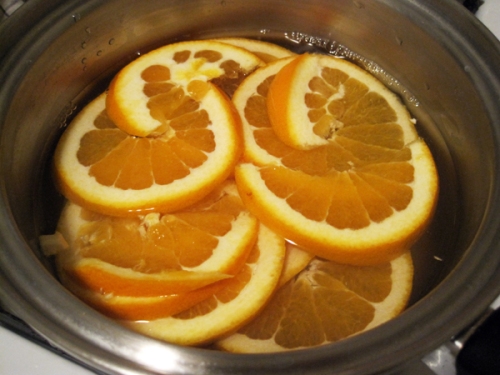

Then I segmented the oranges, which I’ve already mentioned was more difficult than I’d imagined. But then, about halfway through, I watched this tutorial and realized what I’d been doing wrong, and it was much easier. So if you ever want to segment citrus, check out that link first.
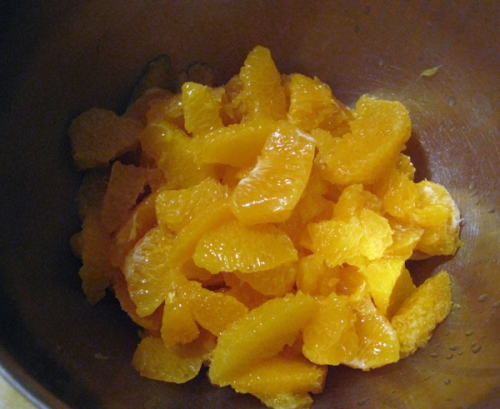
The caramel was really easy to make — you just melt the sugar and then add in the orange juice. If I were to make this again, I might warm the orange juice first. I think the fact that it was so cold, right out of the fridge, contributed to the caramelized sugar seizing up and crystallizing. But then you just keep stirring over medium heat and it all melts together again.

The next day, I put together the pate sablee, which was really similar to my favorite tart dough. I rolled it out and placed the removable bottom of my 9-inch tart pan on top, then cut the circle and baked it. The original recipe called for making 6 individual-sized tartlets using circular cookie cutters, but I don’t have six matching cookie cutters. The full-sized 9-inch tart pan worked really well as an alternative.
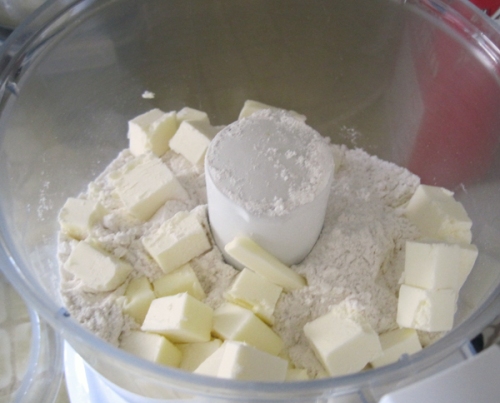
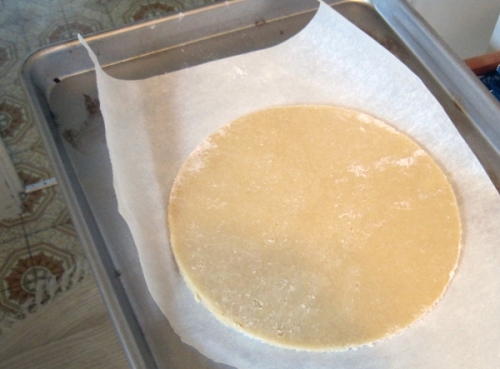
Then there was the stabilized whipped cream, which called for adding gelatin to the cream as you’re whipping it. Um, I don’t recommend using gelatin that has been in your cabinet for God-knows-how-long (long enough that the box is faded and looks like it was bought in 1981) because it just resulted in little tapioca-like granules in the cream. It wasn’t too noticeable in the final product, but I could definitely sense the texture when I tasted the whipped cream before assembling.
And, okay, the assembly. Jeez louise, this is getting long. So you assemble the whole thing upside-down-like. I started out by placing the caramel-soaked, segmented oranges in the bottom of the tart pan (and this is when I ate half of the oranges). Then I dolloped the whipped cream over the oranges and spread it out in an inch-thick layer. Then I spread a thin coating of marmalade over the top of the 9-inch pate sablee circle, and flipped that over onto the whipped cream. Then I froze it for a while. About a half-hour before I wanted to serve it, I took it of the freezer and flipped it onto a plate and removed the tart pan, then let it soften in the fridge.
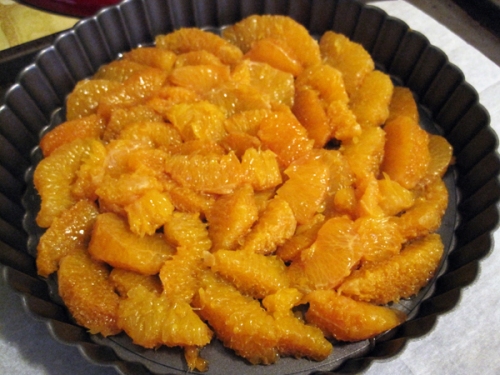
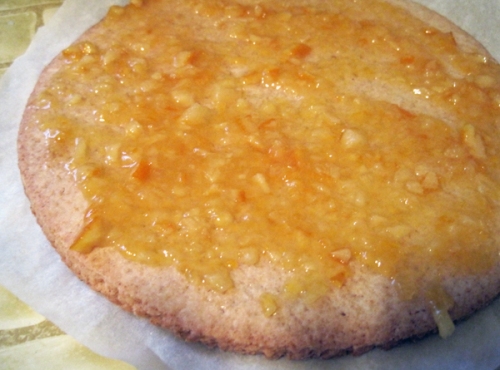

And voila. Lots of hours later, it was all done. And are you wondering what the finished product tasted like? (Are you still reading?) It tasted like Creamsicles. It was very good, but I still think the best part was the candied oranges.
Would I make it again? Not so much. As I said, it certainly tasted good, but it was really time consuming for a dessert that didn’t knock my socks off with awesome.
But that said, it was light and fresh, and if you’re a fan of citrus-based desserts, it’s not a bad one to try. Just, go ahead and cut some corners.
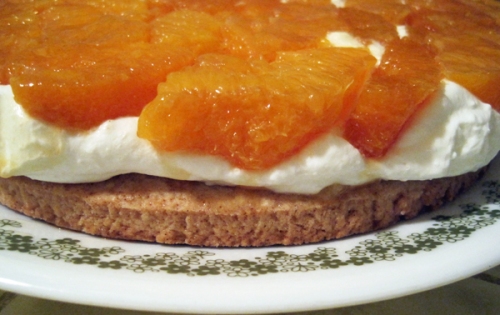
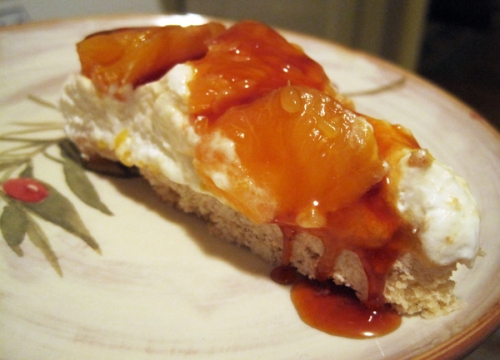
The recipe is below, and also on the Daring Bakers website…
Orange Tian
Adapated from Alain Ducasse‘s Cooking School in Paris
For the marmalade: (This will be easier if you have a kitchen scale)
3.5 oz. orange juice (1/4 cup + 3 tablespoons)
1 large orange, sliced
cold water to cook the orange slices
5 grams pectin
granulated sugar: use the same weight as the weight of orange slices once they are cooked (if you don’t have a kitchen scale, you can measure the orange slices in a cup and then use the same amount of sugar)
Finely slice the orange. Place the orange slices in a medium-sized pot filled with cold water. Simmer for about 10 minutes, discard the water, re-fill with cold water and blanch the oranges for another 10 minutes. Repeat this process once, then once again for a total of 3 times. (Blanching removes the bitterness from the orange peel, so you should use new water every time.)
Drain the slices and let them cool. Once cooled, finely mince them with a knife or food processor. Weigh the minced oranges, then weight the same amount of granulated sugar (or use a measuring cup).
Place the oranges, the sugar, the orange juice, and the pectin in a pot over medium heat. Cook until the mixture reaches a jam consistency, about 10 – 15 minutes. (This took me closer to 25 – 30 minutes of cooking, but I used liquid pectin instead of granulated, so maybe that’s the difference?) Once thick enough, transfer the marmalade to a bowl, cover with plastic wrap, and keep in the fridge.
For the Orange Segments:
Get yourself 8 oranges. Cut them into segments over a shallow bowl and make sure to capture the juice. (Check out this video for instructions on segmenting!) Set aside.
Make the Caramel:
1 cup granulated sugar
14 oz. orange juice (1.5 cups + 2 tablespoons)
Put the sugar in a saucepan over medium heat. It will start to melt after about 5 minutes. Once the sugar starts to bubble and foam, slowly add the orange juice. (It will probably make the sugar seize up — just keep stirring over medium heat until it all melts together again.) Bring the mixture to a boil, then immediately remove from heat and pour half of it over the orange segments.
Reserve the other half of the caramel mixture in a small bowl — you’ll heat this up later to serve along with the assembled dessert. (Shortly before serving the tian, heat the caramel in a small saucepan over low heat until it thickens and coats the back of a spoon, about 15 minutes minutes.)
For the Pate Sablee:
1.5 cups plus 2 T. flour
1 tsp. baking powder
1/4 cup plus 3 T. unsalted butter, cut into pieces and frozen
1/3 tsp. salt
2 egg yolks, at room temperature
6 T. plus 1 tsp. granulated sugar
1/2 tsp. vanilla extract
Put the flour, baking powder, ice-cold cubed butter and salt in a food processor fitted with a steel blade. In a separate bowl, beat the egg yolks, vanilla, and sugar with a whisk until the mixture is light and pale. Pour mixture into the food processor.
Process until the dough just comes together. If the dough is a little too crumbly to come together, add a couple drops of water and process again, until it sticks together. Form the dough into a disc, wrap in plastic, and place in fridge for 30 minutes.
Preheat oven to 350 F. Roll out the dough onto a lightly floured surface to a 1/4-inch thick circle. Place the removable bottom of a 9-inch tart pan over the dough and cut a circle to the shape. Place the large circle of dough onto a parchment-lined cookie sheet. Bake for 20 – 25 minutes, or until the circle is just golden. Set aside to cool to room temp.
For the Whipped Cream:
1 cup heavy whipping cream
3 T. of hot water
1 tsp gelatin
1 T. confectioner’s sugar
1 T. orange marmalade (I omitted this)
In a small bowl, add the gelatin and hot water, stirring well until the gelatin dissolves. Let the gelatin cool to room temperature while you make the whipped cream. (Or just skip this and make normal whipped cream.)
Place the cream in a chilled mixing bowl and whip on low speed until the cream starts to thicken, about one minutes. Add the powdered sugar and increase the speed to medium-high. Whip until the beaters leave visible but not lasting trails in the cream, then add the gelatin while beating continuously. Continue beating until the cream is light and fluffy and forms soft peaks. Transfer the whipped cream to a bowl and fold in the orange marmalade, if using.
Assembling the Dessert:
Make sure you have enough room for a baking sheet in your freezer.
Line baking sheet with parchment, and place 9-inch tart pan on the sheet. Drain the caramel-soaked orange segments on a paper towel, then arrange in a single layer on the bottom of the pan. Try to make it pretty, as this will be the top of your dessert when it comes time to serve it.
Once the oranges are arranged, place several dollops of whipped cream on top of the oranges, then gently spread cream into an even layer. Make sure to leave enough room for the dough circle to be placed on top.
Spread a thin, even layer of orange marmalade over the circle of dough, then carefully place circle marmalade-side-down on top of the whipped cream. Gently press down on the dough to make sure the dessert is compacted together. Place the dessert in the freezer to set. (If serving right away, it only needs to set for 10 minutes. But if you’re serving it later, let it freeze for as long as you want, then unmold it and give it 30 minutes in the fridge to soften up.)
To serve: Using a thin knife, gently go around the edges of the tart pan to make sure the dessert will be easy to unmold. Place a serving plate on top of the tart pan, then turn the whole thing over. Gently remove the tart pan, leaving the tian behind. Cut into 8 slices and serve with warmed caramel sauce.




